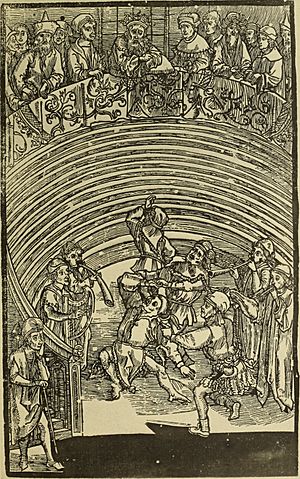Phormio facts for kids

Phormio was a very important Athenian general and admiral. He lived before and during the famous Peloponnesian War. Phormio was a brilliant leader on the sea. He led the Athenian navy to several big victories in 428 BC. After he died, the people of Athens honored him greatly. They put up a statue of him on the Acropolis and gave him a special state funeral. Many people think he was one of Athens' greatest admirals, just like Themistocles and Cimon.
Contents
Phormio's First Commands
Phormio first shows up in history around 440 BC. At that time, he was one of the commanders of the Athenian fleet. This was during the later part of the Samian War, a conflict Athens was fighting.
In 432 BC, Phormio led a group of 1600 hoplites (soldiers). They were sent to help with the siege of Potidaea. This was a city Athens was trying to capture. Phormio and his men slowly moved to the side of the city that Athens had not yet surrounded. They built a wall to completely cut off Potidaea.
After Potidaea was fully surrounded, Phormio led his men on another mission. They had a successful campaign against Athens' enemies in the Chalcidice region. The next year, he led an army there again. This time, he worked with Perdiccas II, who was the king of Macedon.
In the winter of 429/8 BC, Phormio was sent to the Corinthian Gulf. He commanded a fleet of 20 triremes (warships). He set up his base at Naupactus. From there, Phormio stopped ships from Corinth from moving freely.
In the summer of 429 BC, Sparta started getting ready. They prepared a large fleet and army. Their plan was to attack Athens' allies in the area. They hoped to take over Acarnania on land. They also wanted to capture the islands of Zacynthus and Cephallenia. They might even try to take Naupactus itself.
The people of Acarnania were worried. They told Phormio about Sparta's plans. At first, Phormio did not want to leave Naupactus unprotected. However, the Peloponnesian fleet (Spartan and allied ships) began to move. They sailed along the south shore of the Corinthian Gulf. They planned to cross over to Acarnania. The Athenians followed them along the north shore. Once the Peloponnesian ships left the Gulf and tried to cross, Phormio attacked them.
Battle of Rhium: A Clever Tactic
In the battle that followed, called the Battle of Rhium, Phormio used a very unusual tactic. The Peloponnesians had more ships (47 compared to Athens' 20). Many of their ships were also carrying heavy soldiers. They pulled their ships into a defensive circle, with their front parts (prows) facing outwards.
Phormio and his ships started circling the Peloponnesian fleet. They kept circling, making the enemy's circle tighter and tighter. This was a risky move. It left the Athenian ships open to being rammed on their sides. But it worked! A strong wind suddenly blew up. The Peloponnesian crews were not very experienced. The wind caused their oars to get tangled. In this moment of confusion, the Athenians rushed in. They defeated the remaining enemy ships. They captured 12 of them.
Second Battle at Naupactus
Soon after, there was a second battle. Phormio and his small force won again. This time, they faced an even larger Peloponnesian fleet of 77 ships. The Athenians were drawn into the narrow waters of the Corinthian Gulf to protect Naupactus.
At first, the Athenians were scattered and pushed back. But 11 Athenian ships were chased into Naupactus. These ships were able to turn around and attack their pursuers. They defeated the much larger force against them. This victory kept Athens in control of the sea in the Gulf. It also stopped the Peloponnesians from challenging Athens' naval power during that part of the war.
Phormio's Lasting Impact
After a single land campaign in 428 BC in Acarnania, Phormio is not mentioned commanding again. But in just a few years, he made a huge difference. He shaped the early part of the Peloponnesian War. If Athens had lost in the Corinthian Gulf in 429/8 BC, it would have been a terrible blow. It would have hurt Athens' power in the Greek northeast. It would also have damaged their reputation for being unbeatable at sea.
After Phormio died, the Athenians honored his service. They put up a statue of him on the Acropolis. They also buried him in the state cemetery. Phormio's son, named Asopius, also led a naval trip during the war.
See also
 In Spanish: Formión (general) para niños
In Spanish: Formión (general) para niños

